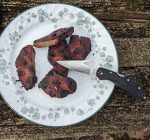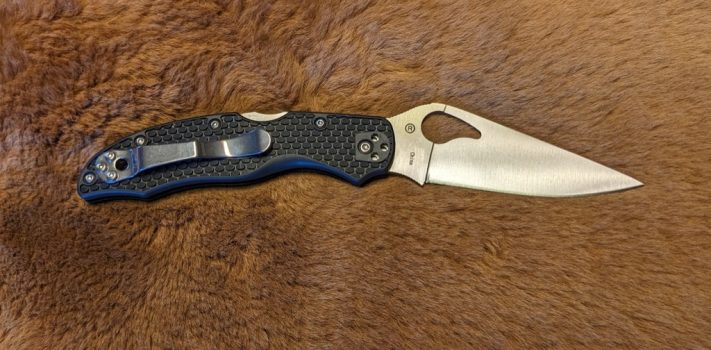I recently purchased a Spyderco Byrd Harrier 2 Lightweight Folding Knife. It has a 3.36-inch full flat grind blade with a plain edge in 8Cr13MoV steel, a fiberglass reinforced nylon handle, a back-lock locking mechanism, a reversible pocket clip, a lanyard hole, and the distinctive Spyderco opening hole (as modified for Byrd) to allow ambidextrous, one-handed opening.
I bought this knife because I had somehow received the impression that it is made in Taiwan. That is, unfortunately, not the case. All Spyderco Byrd knives are made in mainland China. I usually don’t review products made in mainland China, but since I had already invested $35.70 in this knife, I decided to go ahead and review it.
Blade Steels Can Show the Country of Origin
Online retailers often try to hide the origin of products that are made in mainland China. They may bury that information somewhere deep in the specifications, place it in fine print, or not share it at all. I find this lack of transparency frustrating as I consider potential products to review.
I had a helpful insight regarding this problem following my recent errant purchase of the Byrd Harrier 2 knife. I thought that I would share that insight for the benefit of SurvivalBlog readers: it is usually easier to determine the country of origin of various blade steels than it is to determine the country of origin of individual knife models. Furthermore, those blade steels usually give a pretty good clue about possible countries of origin for the finished knife.
For example, the blade of the Byrd Harrier 2 Lightweight Folding Knife is made of 8Cr13MoV steel. A quick internet search will reveal that 8Cr13MoV steel is a product of mainland China. Because a Taiwanese factory is highly unlikely to purchase steel from mainland China, it is equally highly unlikely that a knife with a blade made of 8Cr13MoV steel would be made in Taiwan.
By the same token, AUS-8 steel is made in Japan. The Chinese have long memories and have never forgiven the Japanese for their atrocities in China during the Second World War. As a result, it is highly unlikely that a Chinese factory would purchase steel from Japan, and equally highly unlikely that a knife with a blade made of AUS-8 steel (like many models of the Ontario RAT 1) would be made in mainland China.
This simple guideline can help to quickly identify the probable countries of origin for many knives, thus eliminating some knives from consideration, and prioritizing some others for further attention.
First Impressions
The knife came in a paperboard box that was strong enough to protect the knife without unnecessarily diverting resources from the product to the packaging.
 The knife came out of the box shaving sharp, and it was a relatively smooth shave, too. The black, non-slip fiberglass-reinforced nylon handle was easy to grip. The opening hole in the blade allowed for easy ambidextrous opening. The back-lock provided a solid lock up, and it was also easy to release. The pocket clip seemed sturdy and well-designed. All in all, it seemed to be a well-conceived and well-executed design.
The knife came out of the box shaving sharp, and it was a relatively smooth shave, too. The black, non-slip fiberglass-reinforced nylon handle was easy to grip. The opening hole in the blade allowed for easy ambidextrous opening. The back-lock provided a solid lock up, and it was also easy to release. The pocket clip seemed sturdy and well-designed. All in all, it seemed to be a well-conceived and well-executed design.
The knife felt much less substantial in my hand than the ESEE knife I had previously been testing. This was probably due to its lightweight design. In spite of its light weight, the Spyderco knife seems to be durable.
Testing
 I used the knife for a variety of the mundane tasks of everyday life over the course of more than a month. Those tasks included, but were not limited to, the following:
I used the knife for a variety of the mundane tasks of everyday life over the course of more than a month. Those tasks included, but were not limited to, the following:
- cutting wood away from countersunk screw heads to determine if they were Phillips or if they were T25.
- trimming bubble wrap.
- opening a dose of heartworm medicine for my dog.
- opening a vacuum-sealed package of venison steaks.
- cutting venison steaks while they were on the grill to make sure that they were fully done.
- opening a bag of dried apricots.
- opening letters and boxes.
- opening a bag of Dove chocolate (I highly recommend opening bags of Dove chocolate as often as possible).
- making an opening for a straw in a plastic soft drink lid. I did this in a hospital cafeteria. My friends joked that hospital security would be along soon to arrest me for having a weapon on the premises.
- slipping labels out of the pockets of a binder. My fingers were too thick to fit directly in the pockets.
- cutting strands of Christmas tree lights out of a piece of firewood. The tree had grown around the strings prior to the tree being felled.
- scraping sawdust and cutting shavings from a fatwood stick to use with a ferro rod for starting a fire.
- cutting a fatwood stick in half and feathering it, to use in transferring flame from an ignition point into a rocket stove.
- cutting into a piece of chicken on the grill to make sure that it was fully done.
The knife performed well in all of these tasks and others. Although the full-grind blade appeared to be somewhat fragile near the edge, it held up well to heavy use.
 I found that a knife equipped with an opening hole can be somewhat more pleasant to carry than a knife equipped with thumb studs in spite of the somewhat unusual appearance the opening hole gave to the blade. The opening hole is less likely to snag on something and is less likely to break than thumb studs. It is an elegant design element in the sense that it is simple and effective.
I found that a knife equipped with an opening hole can be somewhat more pleasant to carry than a knife equipped with thumb studs in spite of the somewhat unusual appearance the opening hole gave to the blade. The opening hole is less likely to snag on something and is less likely to break than thumb studs. It is an elegant design element in the sense that it is simple and effective.
8Cr13MoV Steel
8Cr13MoV is a martensitic stainless steel that is corrosion-resistant, relatively inexpensive, and reasonably durable. Martensitic steel derives its hardness from a steel crystalline structure called Martensite.
8 Cr13MoV is composed of 81.87% iron, 14.5% chromium, 1% manganese, 1% silicon, 0.8% carbon, 0.3% molybdenum, 0.25% vanadium, 0.2% nickel, 0.04% phosphorus, and 0.04% sulfur.
Spyderco History
Spyderco was founded in 1976 by Sal and Gail Glesser. They lived a nomadic life, traveling between various fairs and trade shows around the country selling their products. Two of their early products consisted of the “Portable Hand” (a device for helping people who work with small parts) and the “Tri-Angle Sharpmaker” (a knife sharpening system that Spyderco still manufactures). The Glessers lived in a camper made from an old bread truck, and towed a VW bug behind the camper.
In 1978, the Glessers oldest daughter was ready to start school, so they settled in Golden, Colorado. Sal continued to travel the country, while Gail kept the home fires burning. Golden has remained the home of Spyderco ever since.
In 1981, Mr. Glesser designed his first folding knife, the “CO1 Worker”. The knife introduced three novel features for folding knives: an opening hole, a pocket clip, and the option of a serrated blade. These three features have been subsequently adopted by a host of other knife designers.
It is reported that Mr. Glesser made his first prototype of the distinctive opening hole by welding a section of metal with an opening hole in it to the back of the blade of a conventional pocket knife.
It is also reported that the pocket clip was inspired by a frog shaped pocket clip that Mr. Glesser had for his key ring. Evidently, he decided that if a clip was helpful for his key ring, a clip would also be helpful for his knife. The rest is history.
The Byrd Designs
Byrd is a line of Spyderco designed knives manufactured in mainland China. Evidently Spyderco got sick of competitors profiting from inexpensive Chinese copies of their designs, and decided to profit from inexpensive Chinese copies themselves. These knives can be quickly distinguished visually from other Spyderco lines by an opening hole that is comet-shaped rather than round like the opening holes of other Spyderco knife lines.
Folding Knife History
The oldest folding knife that has been recovered to date was found near Hallstatt, Austria, and dates from 500 to 600 BC. Other pre-Roman folding knives have been recovered in Spain. Folding knives were also used during the Roman period and in the Viking age. The earliest folding knives typically depended on friction to keep them open or closed. By the Viking age, many of the knives instead used a catch of some sort to hold the blade open.
With the advent of the industrial revolution, an increasing number of knives were produced using the tension of a backspring to help hold the knife open.
Lock-blade knives were available as early as the 15th century, and came into increasingly common use toward the close of the 20th century.
Conclusions
 The Spyderco Byrd Harrier 2 Lightweight Folding Knife is sharp, easy to grip, easy to open one-handed with either hand, and locks securely open. I would like this knife better with a saber grind than with the full-flat grind that currently characterizes its blade, but that is purely a matter of personal preference. I would also prefer D2 steel to 8Cr13MoV, but that is likewise a matter of personal preference. The only objective significant drawback to this knife is that it is made in mainland China, so buying it will strengthen our country’s chief geopolitical rival.
The Spyderco Byrd Harrier 2 Lightweight Folding Knife is sharp, easy to grip, easy to open one-handed with either hand, and locks securely open. I would like this knife better with a saber grind than with the full-flat grind that currently characterizes its blade, but that is purely a matter of personal preference. I would also prefer D2 steel to 8Cr13MoV, but that is likewise a matter of personal preference. The only objective significant drawback to this knife is that it is made in mainland China, so buying it will strengthen our country’s chief geopolitical rival.
Disclaimer
I did not receive any financial or other inducement to mention any vendor, product, or service in this article.










